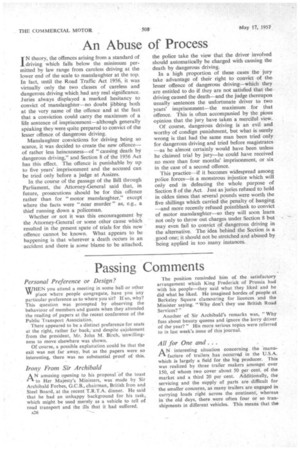Passing Comments
Page 28

Page 29

If you've noticed an error in this article please click here to report it so we can fix it.
Personal Preference or Design?
WHEN you attend a meeting in some hall or other
place where people congregate, have you any particular preference as to where you sit? If so, why? This question was prompted by observing the behaviour of members and guests when they attended the reading of papers at the recent conference of the Public Transport Association. There appeared to be a distinct preference for seats at the right, rather far back, and despite cajolement from the president, Mr. John M. Birch, 'unwillingness to move elsewhere was shown.
Of course, a possible explanation could be that the exit was not far away, but as the papers were so interesting, there was no substantial proof of this.
Irony From Sir Archibald
AN amusing opening to his proposal of the toast to Her Majesty's Ministers, was made by Sir Archibald Forbes, G.C.B., chairman, British Iron and Steel Board, at the recent T.R.T.A. dinner. He said that he had an unhappy background for his task, which might be used merely as a vehicle to tell of road transport and the ills that it had suffered. A26
The position reminded him of the satisfactory arrangement which King Frederick of Prussia had with his people—they said what they liked and he did what he liked. He imagined hordes of people at Berkeley Square clamouring for licences and the Minister saying. "Why don't they use British Road Services?"
Another of Sir Archibald's remarks was, "Why fuss about beauty queens and ignore the lorry driver of the year?" His more serious topics were referred to in last week's issue of this journal.
All for One and. . .
AN interesting situation concerning •the manufacture of trailers has occurred in the U.S.A. which is largely a field for the big producer. This was realized by three trailer makers amongst over 150, of whom two cover about 50 per cent, of the market and a third 20 per cent. Additionally, the servicing and the supply of parts are difficult for the smaller concerns, as many trailers are engaged in carrying loads right across the continent, whereas in the old days, there were often four or so transhipments in different vehicles. This means that the
trailers may now he away for periods of as long as six months with, presumably, relays of drivers.
The three therefore began to produce a standard trailer, although this is sold under their individual names, and they have merely 'divided the whole country into three areas within which this new model is sold by the respective makers. Other products, mostly smaller trailers,continue to be sold com petitively. , Incidentally, the new product is a twin-axled semitrailer built with steel frame members and stressed aluminium panels, and one type is built as an insulated van with a refrigerator floor.
The limited pooling has reduced the cost of materials and parts and facilitated a credit scheme for servicing.
Mobile Axle or Mind?
THE French Academie des Inscriptions recently I discussed a question of interest to historians of transport. It was whether it was possible that the mobile front axle was invented in Central France about 500 B.C. and then forgotten almost immediately until half a millennium later.
The matter arose out of a reconstruction of a chariot found in January, 1953, in the tomb clf a Gaulish princess at Vix, near Chatillon-sur-Seine. Although there survived only the iron and bronze parts of the chariot, the two scholars who presented the theory to the Academic are convinced that the front axle was mobile.
Now it only remains for the U.S.S.R. to produce a chariot—powered, perhaps, by an oil engine—and lost to civilization -since 750 B.C.
The Strange World of Plastics
RECENTLY produced by the Monsanto Chemical Company of America, a 30-min. colour film, "The World That Nature Forgot," was shown last week at the first Press conference held in connection with the 1957 International British Plastics Exhibition and Convention.
This 16-mm. film contains some animated sequences by Halas and Batchelor and illustrates the composition and formation of various plastics materials and laminates for industrial and domestic use Copies are available on free loan from the Public Relations Department, Monsanto Chemicals, Ltd., Monsanto House, Victoria Street, London, S.W.1.
The Convention is to be held at Olympia, London, from July 10-20, 1957, and exhibits will be divided into three main sections: materials, plant and equipment and finished products and components. Many of these apply to the road transport industry in respect of chassis and bodies.




























































































